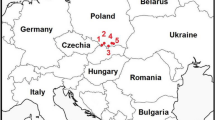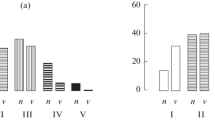Abstract
Most treeline populations in northeastern Canada are monospecific stands of black spruce (Picea mariana [Mill.] B.S.P.), a hardy, cold-tolerant species able to withstand harsh climatic conditions under different growth forms. In the forest tundra, black spruce thrives in protected areas and exhibits a normal arborescent growth form, but in exposed sites, upright stems are damaged above the snowpack by snow abrasion and wind. In this study, the development of damaged growth forms was examined in a moderately exposed habitat. Five developmental stages were identified and described using detailed stem analysis of 13 spruce trees. Four different types of damaged growth forms were identified according to variations in supra-nival (above snow) stem height and number. At the site scale, the age structure of supra-nival shoots, based on a larger sample of 256 stems, was unimodal, suggesting a synchronous development of the spruce stand in which 46% of the shoots were initiated during the 1960s and 1970s. Subfossil trunks on the ground were all depressed trees, indicating that the former vegetation was a krummholz, not a forest. This indicates the recent development of the small-tree stand above the snowpack, probably triggered by recent milder conditions associated with snowier winters in the last decades.
Similar content being viewed by others

References
Arseneault, D. & Payette S. 1992. A postfire shift from lichenspruce to lichen-tundra vegetation at tree line. Ecology 73: 1067-1081.
Barthélémy, D., Édelin C. & Hallé F. 1989. Architectural concepts for tropical trees. Pp. 89-100. In: Holm-Nielsen, L.B., Nielsen I. C. & H. Baslev (eds), Tropical forest. Botanical dynamics, speciation and diversity. Academic Press Ltd.
Bégin, C. 1991. Analyse architecturale et dendroécologique d'une pessière à lichen à la limite des forêts. PhD Thesis, Université Laval, Ste-Foy.
Briffa, K. R. & Jones P. D. 1993. Global surface air temperature variation during the twentieth century: Part 2, implications for large scale high frequency palaeoclimatic studies. The Holocene 3: 77-88.
Daly, C. 1984. Snow distribution patterns in the alpine krummholz zone. Prog. Phys. Geogr. 8: 157-175.
Dvorak, V., Oplustilova M. & Janous D. 1996. Relation between leaf biomass and annual ring sapwood of Norway spruce according to needle age-class. Can. J. For. Res. 26: 1822-1827.
Édelin, C. 1981. Quelques aspects de l'architecture végétative des conifères. Bull. Soc. Bot. Française-Lettres Bot. 128: 177-188.
Édelin, C. 1986. Stratégie de réitération et édification de la cime chez les conifères. Pp. 139-158. Colloque international sur l'arbre. Montpellier.
Environnement Canada. 1989. Sommaire climatique et données météorologiques de la station d'Inukjuak, Québec, Canada.
Filion, L. & Payette S. 1976. La dynamique de l'enneigement en région hémi-arctique, Poste-de-la-Baleine, Nouveau-Québec. Cahiers Géogr. Québec 20: 275-302.
Filion, L., Payette S., Gauthier L. & Boutin Y. 1986. Light rings in subarctic conifers as a dendrochronological tool. Quat. Res. 26: 272-279.
Folland, C. K., Karl T. R. & Vinnikov K. Y. A. 1990. Observed climate variations and changes. Pp. 195-239. In Houghton, J. T., G. J. Jenkins & J. J. Ephraums (eds), Climate change: The IPCC scientific assesment. Cambridge University Press, New York.
Fritts, H. C. 1976. Tree rings and climate. Academic Press, London.
Fritts, H. C. & Swetnam T. W. 1989. Dendroecology: A tool for evaluating variations in past and present forest environments. Adv. Ecol. Res. 19: 111-188.
Grove, J.M. 1988. The Little Ice Age. Methuen & Co. Ltd., London.
Hadley, J. L. & Smith W. K. 1983. Influence of wind exposure on needle dessication and mortality for timberline conifers in Wyoming, USA. Arctic Alpine Res. 15: 127-135.
Hadley, J. L. & Smith W. K. 1986. Wind effects on needles of timberline conifers: seasonal influence on mortality. Ecology 67: 12-19.
Hadley, J. L. & Smith W. K. 1987. Influence of krummholz mat microclimate on needle physiology and survival. Oecologia 73: 82-90.
Hadley, J. L. & Smith W. K. 1989. Wind erosion of leaf surface wax in alpine timberline conifers. Arctic Alpine Res. 21: 392-398.
Jardon, Y., Filion L. & Cloutier C. 1994. Long-term impact of insect defoliation on growth and mortality of eastern larch in boreal Québec. Écoscience 1: 231-238.
Jones, P. D. & Briffa K. R. 1992. Global surface air temperature variations during the twentieth century: Part 1, spatial, temporal and seasonal details. The Holocene 2: 165-179.
Jones, P. D., Wigley T. M. L. & Wright P. B. 1986. Global temperature variations between 1861 and 1984. Nature 322: 430-434.
Kullman, L. 1986. Recent tree-limit history of Picea abiesin the southern Swedish Scandes. Can. J. For. Res. 16: 761-771.
Kullman, L. 1996. Recent cooling and recession of Norway spruce (Picea abies(L.) Karst.) in the forest-alpine tundra ecotone of the Swedish Scandes. J. Biog. 23: 843-854.
Lavoie, C. & Payette S. 1992. Black Spruce growth forms as a record of a changing winter environment at treeline, Québec, Canada. Arctic Alpine Res. 24: 40-49.
Lavoie, C. & Payette S. 1994. Recent fluctuations of the lichenspruce forest limit in subarctic Québec. J. Ecol. 82: 725-734.
Légère, A. & Payette S. 1981. Ecology of a black spruce (Picea mariana) clonal population in the hemiarctic zone, northern Quebec: population dynamics and spatial development. Arctic Alpine Res. 13: 261-276.
Lescop-Sinclair, K. & Payette S. 1995. Recent advance of the arctic treeline along the eastern coast of Hudson Bay. J. Ecol. 83: 929- 936.
Marchand, P. J. 1987. Life in the cold. An introduction to winter ecology. University Press of New England, Hanover.
Marchand, P. J. & Chabot P. F. 1978. Winter water relations af tree-line plant species of Mt. Washington, New Hampshire. Arctic Alpine Res. 10: 105-116.
Payette, S. & Delwaide A. 1994. Growth of black spruce at its northern range limit in arctic Quebec, Canada. Arctic Alpine Res. 26: 174-179.
Payette, S., Delwaide A., Morneau C. & Lavoie C. 1994. Stem analysis of a long lived black spruce clone at treeline. Arctic Alpine Res. 26: 56-59.
Payette, S., Delwaide A., Morneau C. & Lavoie C. 1996. Patterns of tree stem decline along a snow-drift gradient at tree line: a case study using stem analysis. Can. J. Bot. 74: 1671-1683.
Payette, S., Filion L., Delwaide A. & Bégin C. 1989. Reconstruction of tree-line vegetation response to long-term climate change. Nature 341: 429-432.
Payette, S., Filion L., Gauthier L. & Boutin Y. 1985. Secular climate change in old-growth tree-line vegetation of northern Quebec. Nature 315: 135-138.
Robichaud, E. & Methven I. R. 1992. The applicability of the pipe model theory for the prediction of foliage biomass in trees from natural, untreated black spruce stands. Can. J. For. Res. 22: 1118-1123.
Savile, D. B. O. 1972. Arctic adaptations in plants. Agriculture Canada Monograph #6.
Scott, P. A., Bentley C. V., Fayle D. C. F. & Hansell R. I. C. 1987a. Crown forms and shoot elongation of white spruce at the treeline, Churchill, Manitoba, Canada. Arctic Alpine Res. 19: 175-186.
Scott, P. A., Hansell R. I. C. & Fayle D. C. F 1987b. Establishment of white spruce populations and responses to climatic change at the treeline, Churchill, Manitoba, Canada. Arctic Alpine Res. 19: 45-51.
Sokal, R. R. & Rohlf F. J. 1981. Biometry. The principles and practice of statistics in biological research. W.H. Freeman and Company, New York.
Swetnam, T. W., Thompson M. A. & Kennedy Sutherland E. 1988. Using dendrochronology to measure radial growth of defoliated trees. United States Dept. of Agriculture, Forest Service Cooperative State Research Service, Agriculture Handbook #639, Washington D.C.
Wang, L. & Payette, S. 1996. Tree ring density of black spruce at treeline (subarctic Quebec). Ecological Society of America annual meeting. Providence, Rhode Island.
Rights and permissions
About this article
Cite this article
Pereg, D., Payette, S. Development of black spruce growth forms at treeline. Plant Ecology 138, 137–147 (1998). https://doi.org/10.1023/A:1009756707596
Issue Date:
DOI: https://doi.org/10.1023/A:1009756707596



